
How to Use Raspberry Pi 5: Examples, Pinouts, and Specs
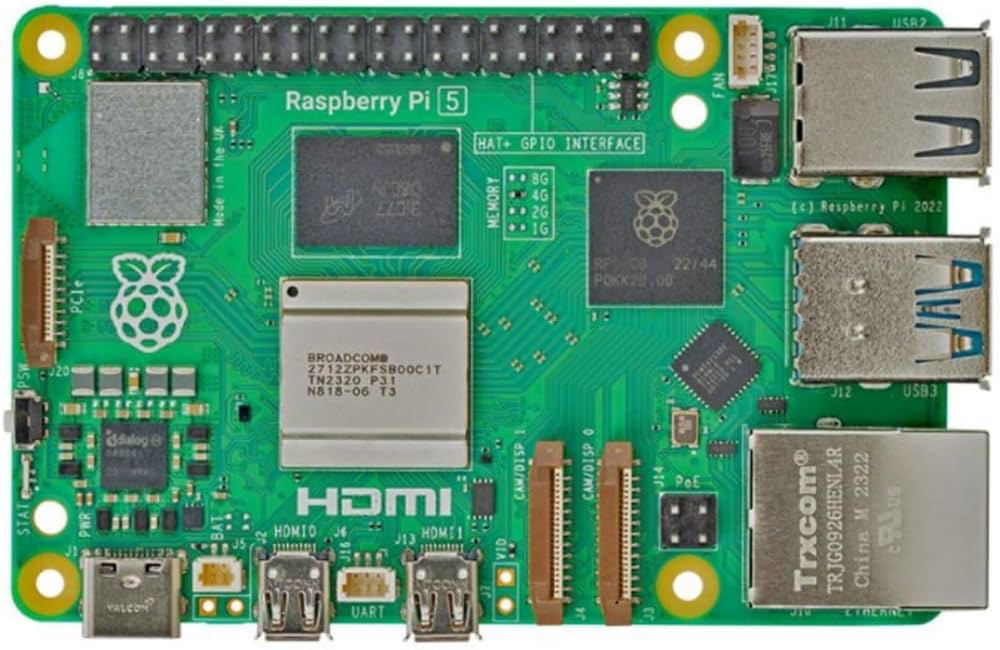
 Design with Raspberry Pi 5 in Cirkit Designer
Design with Raspberry Pi 5 in Cirkit DesignerIntroduction
The Raspberry Pi 5, manufactured by Raspberry, is a compact and affordable single-board computer (SBC) designed for a wide range of applications. It is the latest iteration in the Raspberry Pi series, offering significant improvements in processing power, graphics performance, and connectivity. The Raspberry Pi 5 is ideal for educational purposes, prototyping, IoT projects, and hobbyist applications. Its versatility makes it suitable for tasks such as programming, media playback, home automation, and more.
Explore Projects Built with Raspberry Pi 5
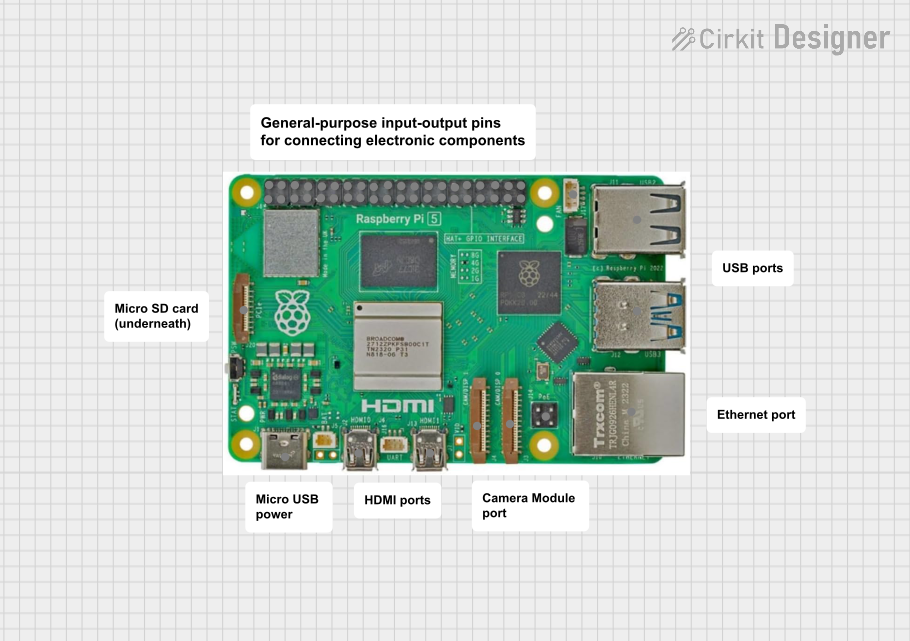
 Open Project in Cirkit Designer
Open Project in Cirkit Designer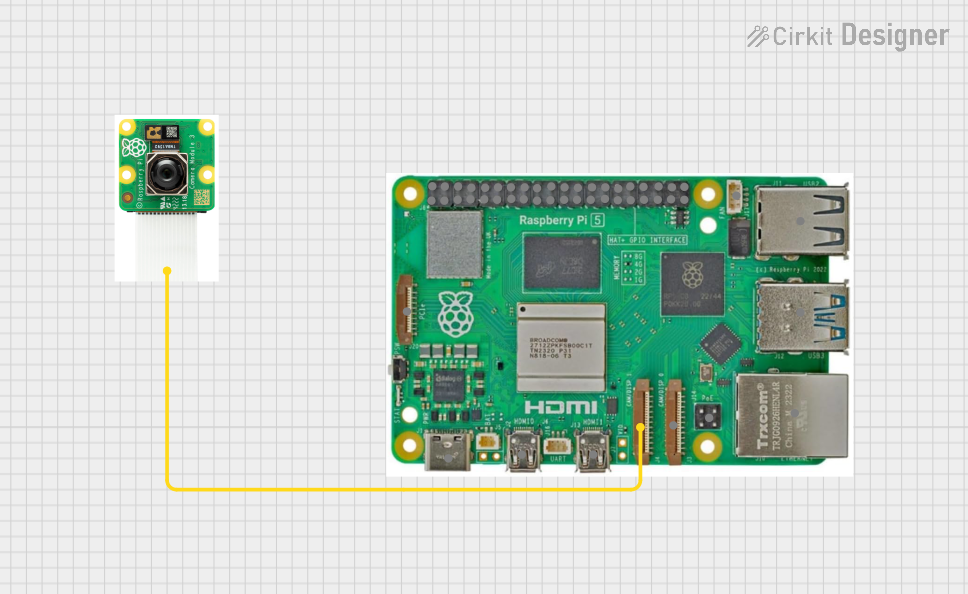
 Open Project in Cirkit Designer
Open Project in Cirkit Designer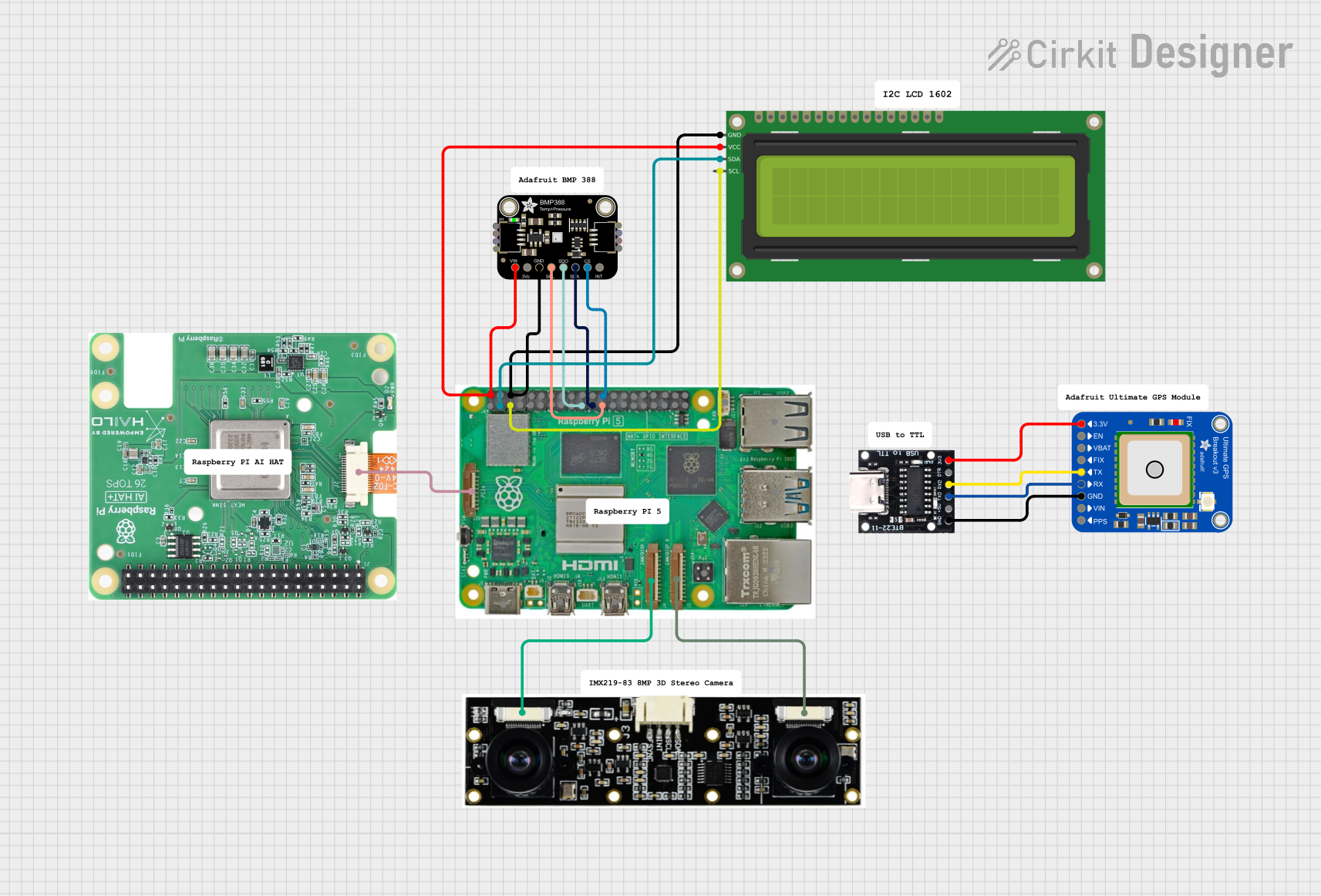
 Open Project in Cirkit Designer
Open Project in Cirkit Designer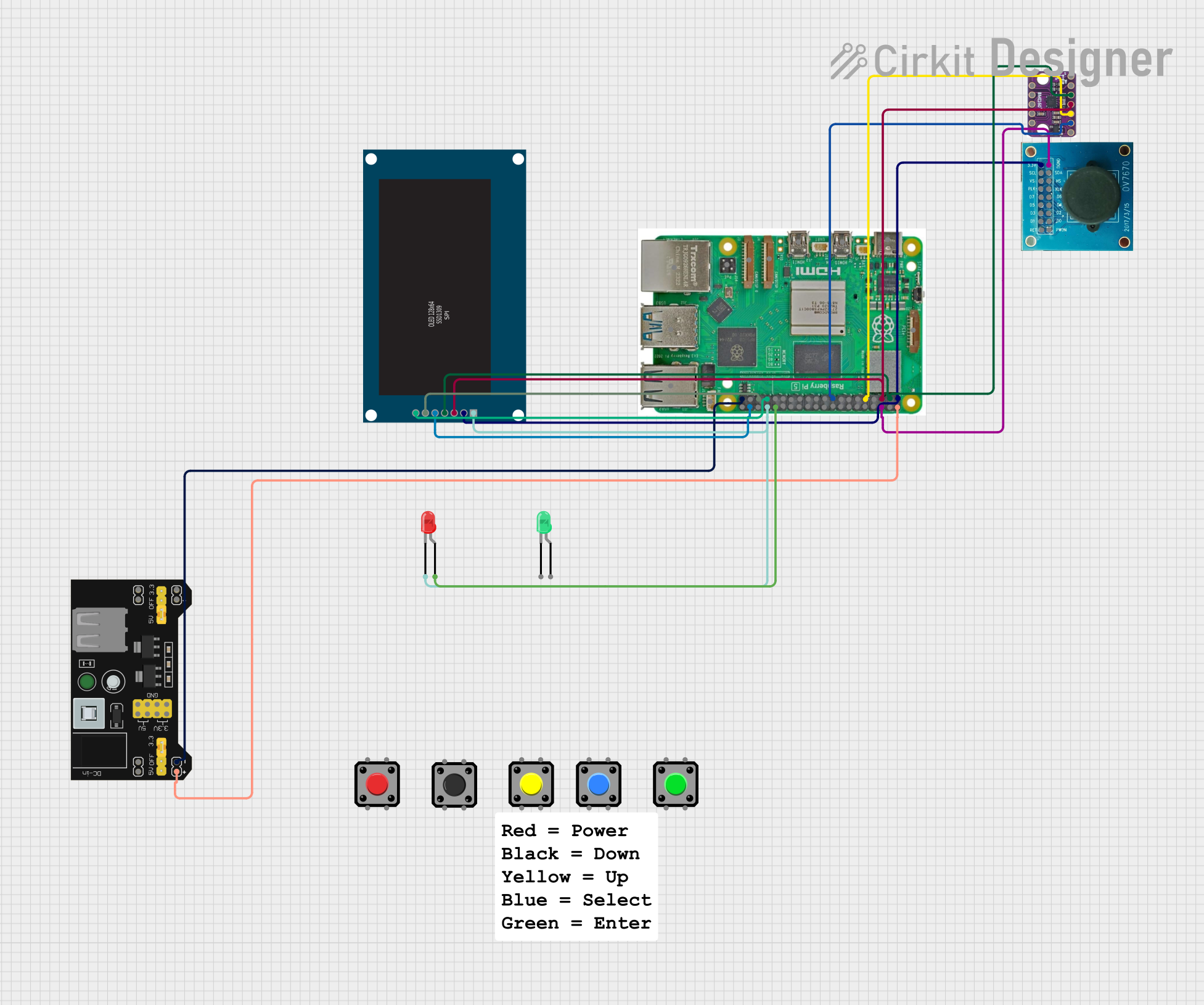
 Open Project in Cirkit Designer
Open Project in Cirkit DesignerExplore Projects Built with Raspberry Pi 5

 Open Project in Cirkit Designer
Open Project in Cirkit Designer
 Open Project in Cirkit Designer
Open Project in Cirkit Designer
 Open Project in Cirkit Designer
Open Project in Cirkit Designer
 Open Project in Cirkit Designer
Open Project in Cirkit DesignerCommon Applications
- Education: Teaching programming, electronics, and computer science.
- Prototyping: Developing and testing hardware and software solutions.
- Media Center: Streaming and playing high-definition video and audio.
- IoT Projects: Building smart devices and home automation systems.
- Gaming: Running retro games and lightweight gaming applications.
- AI and Machine Learning: Running small-scale AI models and experiments.
Technical Specifications
Key Technical Details
| Specification | Details |
|---|---|
| Processor | Quad-core ARM Cortex-A76, 2.4 GHz |
| GPU | VideoCore VII, supporting 4K video playback and OpenGL ES 3.1 |
| RAM Options | 4GB, 8GB, or 16GB LPDDR4X |
| Storage | MicroSD card slot, support for external USB 3.0 storage |
| Connectivity | Dual-band Wi-Fi 6, Bluetooth 5.2, Gigabit Ethernet |
| USB Ports | 2x USB 3.0, 2x USB 2.0 |
| Display Outputs | 2x micro-HDMI ports, supporting up to 4K@60Hz |
| GPIO Pins | 40-pin GPIO header, backward compatible with previous Raspberry Pi models |
| Power Supply | USB-C, 5V/5A |
| Dimensions | 85.6mm x 56.5mm x 17mm |
| Operating System | Raspberry Pi OS (Linux-based), supports other Linux distributions |
Pin Configuration and Descriptions
The Raspberry Pi 5 features a 40-pin GPIO header, which is backward compatible with earlier Raspberry Pi models. Below is the pinout configuration:
| Pin Number | Pin Name | Description |
|---|---|---|
| 1 | 3.3V Power | 3.3V power supply |
| 2 | 5V Power | 5V power supply |
| 3 | GPIO 2 (SDA1) | I2C Data |
| 4 | 5V Power | 5V power supply |
| 5 | GPIO 3 (SCL1) | I2C Clock |
| 6 | Ground | Ground |
| 7 | GPIO 4 | General-purpose I/O |
| 8 | GPIO 14 (TXD) | UART Transmit |
| 9 | Ground | Ground |
| 10 | GPIO 15 (RXD) | UART Receive |
| ... | ... | ... |
| 39 | Ground | Ground |
| 40 | GPIO 21 | General-purpose I/O |
For the full GPIO pinout, refer to the official Raspberry Pi documentation.
Usage Instructions
How to Use the Raspberry Pi 5 in a Circuit
Powering the Raspberry Pi 5:
- Use a USB-C power adapter capable of delivering 5V/5A.
- Ensure the power supply is stable to avoid performance issues.
Connecting Peripherals:
- Attach a monitor via the micro-HDMI ports.
- Connect a keyboard and mouse via the USB ports.
- Insert a microSD card with the Raspberry Pi OS installed.
Using GPIO Pins:
- Use the 40-pin GPIO header for interfacing with external components like LEDs, sensors, and motors.
- Be cautious about voltage levels; GPIO pins operate at 3.3V logic.
Networking:
- Connect to the internet via Wi-Fi 6 or Gigabit Ethernet for faster data transfer.
Booting the Raspberry Pi 5:
- Insert the microSD card, connect peripherals, and power on the device.
- Follow the on-screen instructions to complete the initial setup.
Important Considerations and Best Practices
- Cooling: The Raspberry Pi 5 can generate heat under heavy loads. Use a heatsink or fan for proper cooling.
- Static Protection: Handle the board with care to avoid static discharge, which can damage components.
- Software Updates: Regularly update the Raspberry Pi OS to ensure optimal performance and security.
- Power Supply: Use a high-quality power adapter to prevent undervoltage warnings.
Example: Blinking an LED with GPIO
Below is an example of how to blink an LED using the Raspberry Pi 5 and Python:
Import the GPIO library and time module
import RPi.GPIO as GPIO import time
Set the GPIO mode to BCM (Broadcom pin numbering)
GPIO.setmode(GPIO.BCM)
Define the GPIO pin connected to the LED
LED_PIN = 18
Set up the LED pin as an output
GPIO.setup(LED_PIN, GPIO.OUT)
Blink the LED in a loop
try: while True: GPIO.output(LED_PIN, GPIO.HIGH) # Turn the LED on time.sleep(1) # Wait for 1 second GPIO.output(LED_PIN, GPIO.LOW) # Turn the LED off time.sleep(1) # Wait for 1 second except KeyboardInterrupt: # Clean up GPIO settings on exit GPIO.cleanup()
---
Troubleshooting and FAQs
Common Issues
The Raspberry Pi 5 does not boot:
- Ensure the microSD card is properly inserted and contains a valid OS image.
- Check the power supply for sufficient voltage and current.
Overheating:
- Use a heatsink or fan to cool the board.
- Avoid placing the Raspberry Pi 5 in an enclosed space without ventilation.
No display output:
- Verify the micro-HDMI cable is securely connected.
- Ensure the monitor is set to the correct input source.
GPIO pins not working:
- Double-check the pin configuration and connections.
- Ensure the GPIO library is installed and properly configured.
FAQs
Can I use older Raspberry Pi accessories with the Raspberry Pi 5?
- Yes, most accessories like cases, power supplies, and HATs are compatible, but verify specifications.
What operating systems are supported?
- The Raspberry Pi 5 supports Raspberry Pi OS and other Linux-based distributions like Ubuntu.
How do I update the firmware?
- Use the following command in the terminal:
sudo apt update && sudo apt full-upgrade
- Use the following command in the terminal:
Can I power the Raspberry Pi 5 via GPIO pins?
- Yes, but ensure proper voltage (5V) and current are supplied to avoid damage.
This concludes the documentation for the Raspberry Pi 5. For further details, refer to the official Raspberry Pi website.